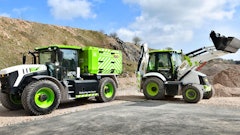
Two Grove cranes are constructing a massive soccer stadium in Brazil for the 2014 World Cup. The Arena Corinthians, located on the east side of São Paulo, will host some of the tournament’s games before becoming the new home of the Brazilian Club Corinthians soccer team. The World Cup is a high-profile event, watched around the world — and it’s no surprise that Grove cranes are playing a vital role in completing this high-profile job.
A Grove RT765E-2 rough-terrain crane and GMK6220L all-terrain crane are on the Arena Corinthians job site, assisting in the stadium pre-assembly. They are unloading construction materials weighing as much as 34 t (37 USt) and lifting them to heights of 33 m (108 ft.) in limited space and windy conditions.
São Paulo-based LOCAR is the company supplying the crane to Odebrecht, which is in charge of the stadium’s construction. Leanderson Dias, equipment supervisor at LOCAR, says the two Grove cranes are working on a tight schedule, but handling the cramped working quarters and windy conditions with ease.
“Odebrecht reports that both the Grove RT765E-2 and the GMK6220L are doing an excellent job on the site,” Dias says. “They are durable, versatile machines and are playing a significant role in streamlining the construction process.”
The 60 t capacity (65 USt) Grove RT765E-2 brings 33.5 m (110 ft.) of boom to the job site. It features four-wheel, multi-mode steering that offers better handling and mobility. Its moderate size makes it adept at navigating rough or cramped job sites. The GMK6220L provides a six-section, full power 72 m (236 ft.) boom and a 220 t (242 USt) capacity.
For the World Cup games, Arena Corinthians will seat 65,000 fans. After the tournament is over, the capacity will be reduced to 48,000 people. The stadium will have a spacious plaza at ground level and an underground field. The roof of the stadium will feature photovoltaic cells that generate energy for the building. The project began in May of 2011 and is due to finish this December.


























